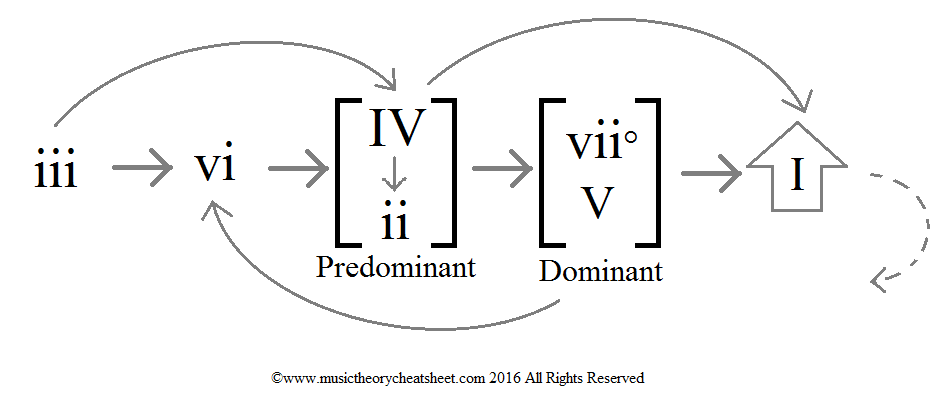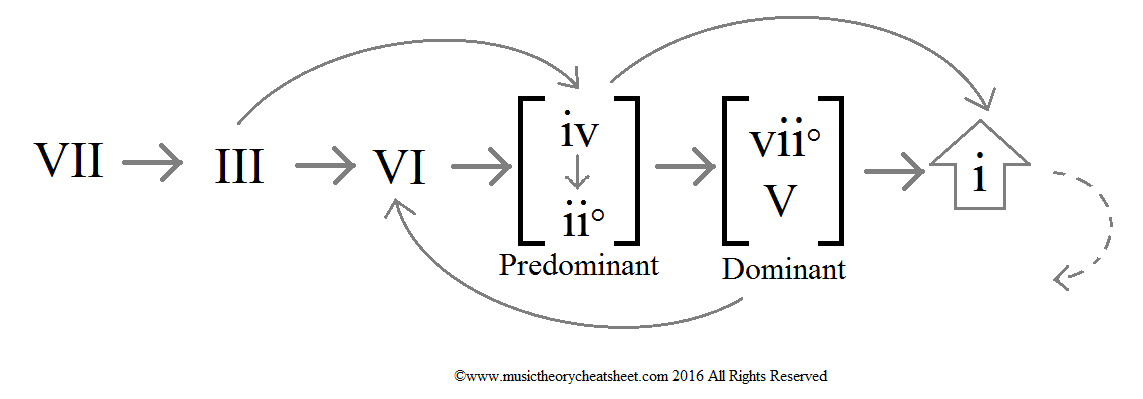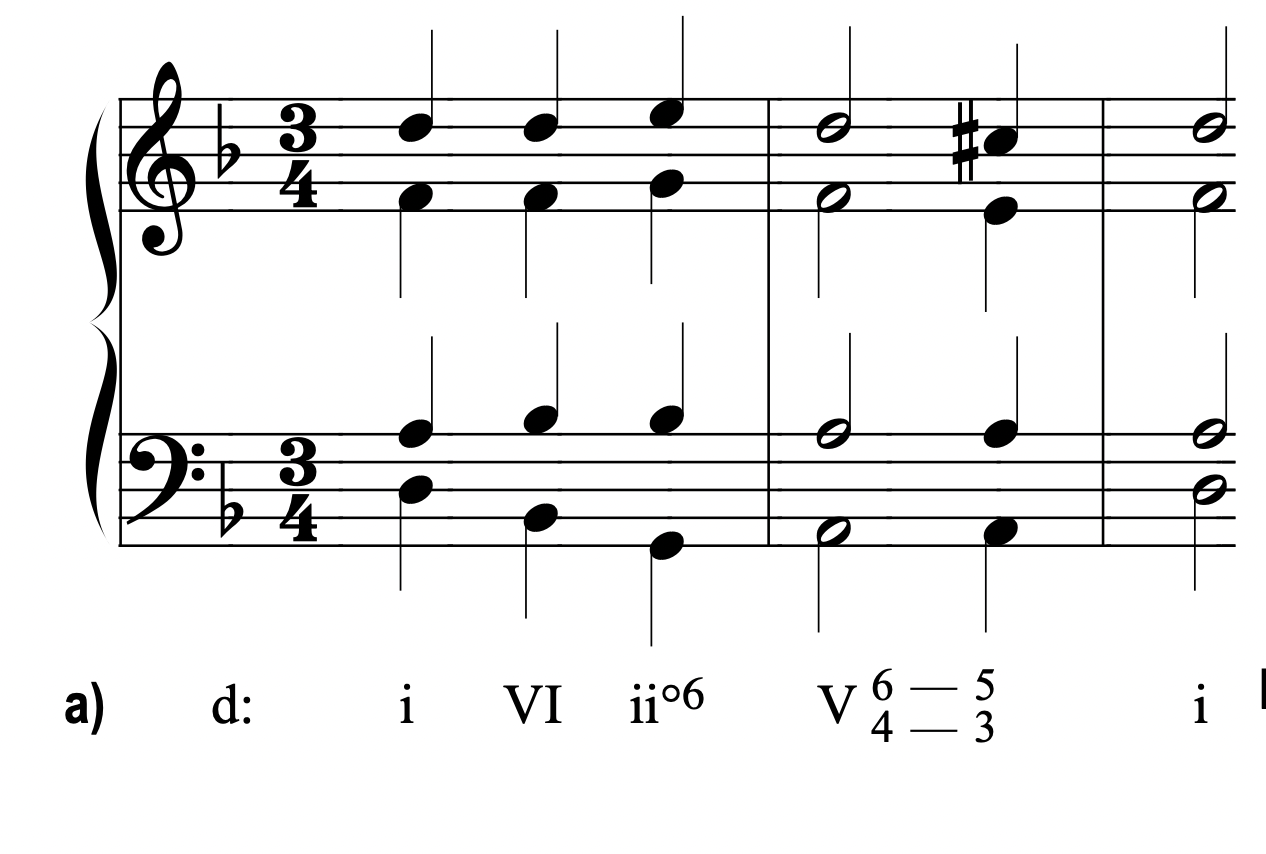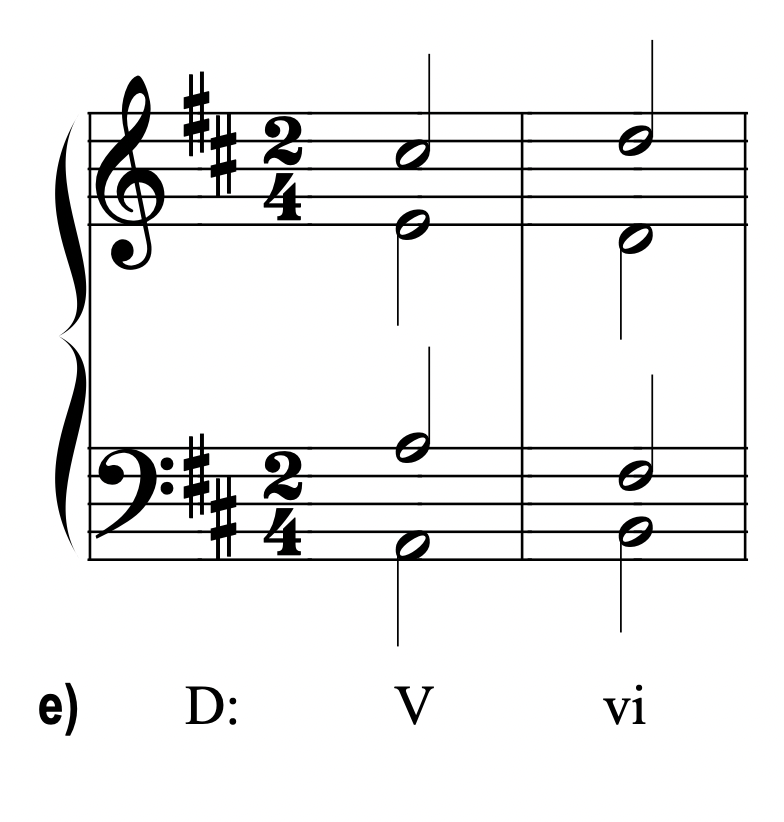Sumi Vora
AP Music Theory 🎶
72 resourcesSee Units
So far, we’ve reviewed the tonic, dominant, and predominant sections of a phrase, and we’ve categorized I or i chords as tonic chords, V and viio chords as dominant chords, and ii and IV (or iio and iv) chords as predominant chords. What’s left to cover in the diatonic scale? The mediant and the submediant chords.
In this guide, we’ll just be talking about the submediant chord (i.e. the iv chord in Major and the IV chord in minor). First, though, let’s review what we already learned.
All chords have different harmonic functions, which are determined both by the way the chord sounds and where and how the chord is placed within a harmonic progression. The second part of the definition is important: harmonic function depends on where and how a chord fits inside of a harmonic progression!
The most common types of phrases are T-PD-D-T phrases, which stand for tonic-predominant-dominant-tonic phrases. The tonic section of the phrase is the most harmonically stable. When we are in the tonic section of a phrase, we feel like we are already home, and we don’t really feel like there is a need to go somewhere.
When we are in the dominant section of a phrase, we feel like we want to go back to the tonic. The dominant section of phrases is usually pretty short. For T-D-T phrases (tonic dominant tonic phrases) the phrase structure is usually like tooooooooooniccccccccc-dominant-tonic, meaning that the first tonic section will take up the most time.
Since the tonic section lacks tension and melodic interest, we add a predominant section after the first tonic section. The predominant section contains all of the ooey gooey harmonic that pull us away from the tonic and lead us into the dominant section. The IV and ii6 chords (in Major) and the iv and iio6 chords (in minor) are the primary chords of the predominant section, because the subdominant has a strong tendency to resolve to the dominant (just like the leading tone has a strong tendency to resolve to the tonic).
Where does the submediant chord fit in? There are three primary functions of the submediant chord: first, it helps expand the tonic area of a harmonic progression; second, it serves as a weak subdominant chord; and third, it is used frequently in deceptive cadences.
Here is a basic template for constructing a phrase in Major:

And here is one for minor:

Images via musictheorycheatsheet.com
Notice that the submediant falls just before the predominant section.
Submediant as a Tonic Expansion
You might notice that the submediant is only one chord tone away from the tonic. This lends very well to using the vi/VI chord as a substitute for the tonic in some cases. For example, you can have a T-D-T (tonic dominant tonic) chord with a I-vi-V-I progression, where the the tonic moves to the vi before we enter the dominant area.
Keep in mind that the submediant chord is not a substitute for the predominant section, although we’ll talk about how it might be considered a “weaker” predominant. In this case, though, it is more accurate to say that the vi chord is a tonic expansion chord because there are no other predominant chords, so we don’t hear a predominant section of the phrase.
There are two things to note about the submediant chord. First, it is a pretty weak chord, so we generally only see it in root position. If it was in first inversion, it might just sound like a tonic chord with a wrong note, and it’s not really useful in second inversion, because the mediant chord is also not a very strong chord.
Second, we don’t really see the vi chord sandwiched in the middle of two tonic chords. While we saw earlier how inversions of the V and vii chords can be used as a pedal tone (a tone that we visit for just a second before returning to the original chord) between two tonic chords, or as a transition chord between two inversions of the tonic chord, this is not really the case for the vi chord. This is because the vi chord is also considered a weak predominant chord.
Submediant as a Weak Predominant Chord
The submediant chord can also be considered a weak predominant chord, which means that even though it does replace the tonic in some cases, it also pulls away from the tonic. The submediant flows well into the supertonic: a common chord progression in a tonic-predominant-dominant-tonic phrase might be I-vi-ii6-V7-I.
Here is an example of such a progression in minor. Don't worry too much about the V 6/4 chord just yet. We'll learn about that in Section 5.6

Image via FSU
Deceptive Cadences
A deceptive cadence begins with a V chord, just like an authentic cadence, but then it doesn’t resolve to the tonic. Composers often use deceptive cadences when they want a phrase to lead into the next phrase. Earlier, we compared cadences to musical punctuation. Authentic cadences can be thought of as periods: they decisively end phrases. Deceptive cadences are more like commas or dashes: they leave you wanting more, and the phrase doesn’t sound complete until you’ve ended on a more decisive chord.
Often, in deceptive cadences, the dominant resolves up to the tonic. This gives a little bit of a sense of musical surprise, because we don’t really expect the V chord to flow to the vi chord.

Image via FSU
Introduction to Contextual Analysis
You might be thinking: the submediant chord has so many different uses depending on the context! How can I categorize it into the tonic, dominant, and predominant groups we’ve already created? The short answer is that most of the time, we’ll attach it to the tonic category, since it’s usually used to expand the tonic.
The longer, more accurate answer is that these categories are just generalizations and we shouldn’t take them too seriously. Just because vi chords are in the tonic category, it doesn’t really mean that they function as a tonic chord in all instances. What really matters is the context.
Let’s take, for example, a chord progression where there is a I-V 4/3-I6 harmonic progression. We might say: hey, that looks a lot like a T-D-T phrase, because there is a I chord followed by a V chord followed by another I chord.
However, if you actually heard fhis progression being played, you wouldn’t hear a very strong V-I resolution, because the V 4/3 inversion of the V7 chord has the supertonic (second scale degree) in the bass, so the bass line moves up stepwise, going from a tonic chord in root position, to a chord with the 2nd scale degree in the bass, to another I6 chord, with the 3rd scale degree in the bass.
What does that mean for us music theorists? It means that, for the listenee, the V 4/3 chord doesn’t function as a dominant chord: instead, it works as a transition chord between two tonic chords, and so the V 4/3 is also in the tonic section of the piece. In other words, during the chord progression, we don’t hear “home, tension, home”. Rather, we just hear “home, home, home.” So, the V 4/3 chord has a tonic function in this chord progression.
This is the whole point behind contextual analysis. Contextual analysis in music theory means interpreting the function of each chord in terms of its function within a chord progression rather than definitively assigning functions to each of the diatonic chords.
This doesn’t necessarily mean that there aren’t certain rules and heuristics to help you figure out what the function of a chord is. It is very likely, for example, if you see a vii chord or a V chord towards the end of a harmonic progression, that chord will be serving a dominant function. Similarly, the first few chords of a chord progression, if they contain a tonic chord, will probably have a tonic function.
What about the vi chord? Well, this is where contextual analysis becomes a useful tool. There might be times when you know that the vi chord is serving as a substitute for the I chord. Usually, if there are tonic chords followed by a vi chord, but there are no other chords that usually function as predominant chords, we will usually hear the vi chord as a tonic expansion chord. You can put it in the tonic section.
However, if there are other predominant function chords directly following the vi chord, then it is appropriate to label the vi chord as a weak predominant chord. This is especially true if the vi chord is followed by a ii or ii6 chord. In this case, you can label the vi chord as a predominant chord.
Deceptive cadences are easy to spot. If the vi chord is preceded by a V chord, and the vi chord is at the end of a phrase,it is most likely a deceptive cadence.
🦜 Polly wants a progress tracker! What are the three possible functions of a submediant chord in a piece of music? Write a chord progression (using proper voice leading) to illustrate each of these three functions, and label the tonic, predominant, and dominant sections of each.
Browse Study Guides By Unit
🎵Unit 1 – Music Fundamentals I (Pitch, Major Scales and Key Signatures, Rhythm, Meter, and Expressive Elements)
🎶Unit 2 – Music Fundamentals II (Minor Scales and Key Signatures, Melody, Timbre, and Texture)
🎻Unit 3 – Music Fundamentals III (Triads and Seventh Chords)
🎹Unit 4 – Harmony and Voice Leading I (Chord Function, Cadence, and Phrase)
🎸Unit 5: Harmony and Voice Leading II: Chord Progressions and Predominant Function
🎺Unit 6 – Harmony and Voice Leading III (Embellishments, Motives, and Melodic Devices)
🎤Unit 7 – Harmony and Voice Leading IV (Secondary Function)
🎷Unit 8 – Modes & Form
🧐Exam Skills
📚Study Tools

Fiveable
Resources
© 2025 Fiveable Inc. All rights reserved.